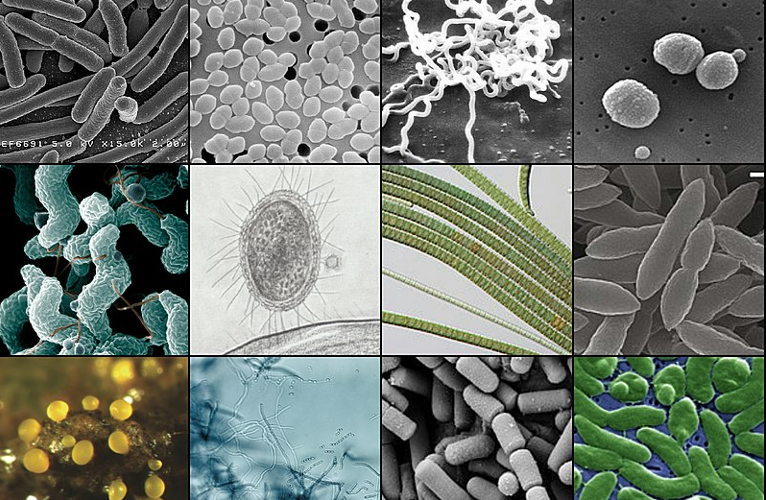Among the most visible species threatened with extinction are leopards, tigers, elephants, orangutans, gorillas and rhinoceroses. What may be of even greater consequence, however, are the millions of species we cannot see, the microbiome of the Earth which is essential to the life of plants and animals worldwide. As the Sixth Great Extinction proceeds, our attention ought to turn as much to these tiny creatures as to the ones who make good television commercials because we can relate to them and because they are such large and grand products of evolution on our planet.
In a recent paper, scientists outline the stakes:
Microbes regulate the major biogeochemical cycles on Earth, to the extent that signatures of microbial biogeochemical activity underpin efforts to discover extraterrestrial life. By regulating global nutrient cycles, greenhouse gas exchange, and disease transmission and protection, the Earth microbiome provides an essential life-support system to our planet. A functioning Earth without a functioning microbiome is nearly unimaginable.
Back in 2017 I asked, “Which species can we do without?” I provided a preliminary but not very helpful answer: “The answer so far is the ones that have already gone extinct while we humans have been around on the planet.” But that leaves unanswered which of the remaining species we could do without. I observed:
If you consider that the broader world with which we interact has millions of species of which we are not aware, it becomes apparent that the Sixth Great Extinction is a rather clumsy and thoughtless way to play Russian roulette with human existence. We could easily cause an organism essential to our survival to go extinct without even realizing it.
Humans have complex dependencies on microorganisms—in our bodies, in the soil in which our food and fiber crops grow, and in the sea from which we take food. The very cycles of the Earth are in part governed by these organisms, so it is hard to see how we could get along without them.
But, are their number and dominance so great that we don’t need to worry about their survival? The authors of the paper cited above tell us that there are “6 million to 8 million terrestrial fungi and up to 1 trillion species of prokaryotes [organisms having cells without a nucleus].” (Eukaryotes, by contrast, are organisms having cells with nuclei and include “all animals, plants and fungi.”) Visual Capitalist compares the total weight of various types of life on Earth. The numbers would make you reasonably believe that the dominate form of life on the planet is plants with 450 gigatons (Gt) of total mass (based on carbon content). Bacteria come in at 70 Gt. Fungi weigh 12 Gt. Humans, however, weigh a mere 0.06 Gt in aggregate. How could we be a threat to these other types of life?
Obviously, our total weight is not the problem. It is our ability and willingness to take over vast stretches of habitat and remake them for our purposes—which always leads to a dramatic reduction in the diversity of life within that habitat. The authors of the paper cited above report that:
A century of monitoring shows a remarkable 45% decline in mushroom-forming mycorrhizal fungi across Europe, probably due to land conversion and intense nitrogen pollution. Anecdotal reports of fungal species extinctions around the world are increasingly pervasive but require additional and repeated monitoring efforts. One example includes the link between extensive forest harvesting in Norway and extinctions of key wood-decay fungi. Furthermore, microbes, which can evolve extremely specialized symbiotic networks of interactions with their plant hosts, are threatened by accelerated co-extinction, as their hosts face increasing population declines.
It’s hard to imagine life on Earth without fungi. Plants collaborate with fungi to survive on land. And, without land plants it’s difficult to imagine human society at the scale we see today or at any scale, actually. Even viruses—the vast majority of which are not pathogenic to humans—play an important balancing role that maintains biodiversity in the ecosphere.
It shouldn’t be surprising that “wild” soils contain much richer biodiversity and that farmers are already “transplanting” such wild soils into their fields to take advantage of that biodiversity. Why? Because as the paper authors point out: “Plants growing with wild microbes generally outperform those that are not. Importantly, past work has shown that the effects of natural soil microbiome transplants far outweigh those associated with commercially available soil microbial mixtures.”
They add: “It would be incredibly valuable to develop ways to introduce wild microbial communities without destructive soil excavation.” Disturbing the soil in the ways modern agriculture requires is part of the cause for the loss of soil biodiversity.
Are there other reasons we should prefer natural soil biodiversity? Not surprisingly, the authors offer additional reasons:
[S]ystems with incredibly low ecological and genetic diversity are more susceptible to extreme climate events. This is worrying as these events are becoming increasingly frequent in the face of global climate change. Monoculture systems are likewise more susceptible to pathogens and pests, creating a need for regular and substantial applications of pesticide to remain viable.
The authors further note:
As we erode this biodiversity, we close doors on novel ways to support our managed food and forest landscapes. More profoundly, we lose billions of years of evolutionary insight.
Think of this last statement as an admission that the microbes of the world are much smarter than we are at maintaining and optimizing conditions for life. If we are serious about protecting biodiversity, we should consider starting with the smallest among us.
Image: Collage of Bacteria (3 September 2022). By 148LENIN via Wikimedia Commons. https://commons.wikimedia.org/wiki/File:Bacteria_collage.jpg. See that page for list of organisms.






